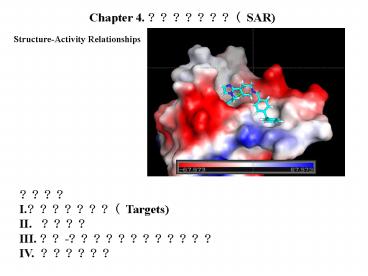Chapter 4. ???????(SAR) PowerPoint PPT Presentation
Title: Chapter 4. ???????(SAR)
1
Chapter 4. ???????(SAR)
Structure-Activity Relationships
- ????
- ???????(Targets)
- II. ????
- III. ??-????????????
- IV. ??????
2
I. ???????(Targets)
??(Receptors)?????????????,??????????
?????????(signal transduction pathway) ?(Enzymes)
????(Ion Channels) ???? ??(Nucleic
Acids) ????(Immune System) ??(Gene)
3
??(Receptors)
- ????????????????????????????
- ????????
- ??????????????????
- ??????????
- ?????(isomers)
- ????????,?
- ???(Agonist),???????,?????,?????????
- ???(antagonist),???????,?????,??????????
- ????(?3-1)
- ???????????????,???????????
- GPCR (G protein coupled receptor)
- ??-?????
- ???????
????
4
- Direct ligand-gated ion channel receptor
????,45???a??(2025 AA)??????????,???????,???????
?????,??????????????????,GABAA??,?????,5-?????,???
??
Acetylcholine
g-aminobutyric acid (GABA)
5-hydroxy tryptamine (5-HT)
glutamic acid
5
2YMD Choline receptor/5-HT
4MS3 GABAb receptor/GABA (Nature 2013)
4OO9 glutamate receptor 5 (Nature 2014)
6
????(Ion channels)
Ca2, K, Na, Cl-??
4MS2 Ca2 channel (Nature 2014)
7
2. GPCR (?????4060 ) G-Protein heterotrimer
(a/b/g), ??GTP GPCR ????,N???,7?a helix(2025 AA
each) ??????,?????? ??GPCR???????,?????,????,????
??,??,???? ?????????Ca2, K?? ?3-2,
3-3 ???GPCR???b-?????????H1?????H2?????m???5-HT3
??????D2?? (?3-2)
4NC3 5-HT2B (Science 2014)
8
3.Tyrosine protein kinase receptor
?????????????,?????tyrosine residue, ??insuline,
cytokine, EGFR,PDGFR,VEGFR,Bcr-abl
kinase ????,400700AA,??????????,??????,????ATP???
?,ATP??????tyrosine???????????(oncogene)??????,???
???????(?3-3)
Imatinib (Glivec by Novartis for 10 cancers eg.
CML, GISTs ), targeting Bcr-Abl kinase
Leflonomide for RA, psoriatic arthritis,
targeting PDGFR, F80 t1/22 weeks
4. Nuclear hormone receptor ??DNA??,??????(??????
??????????)?????????D3????A????(?3-4)
9
?(Enzymes)
???????????/?????????? ??????????????????????????
??,1/3 ???????? ?????????????????Isozyme????,?????
??,?????????????????,??off-target???
Omeprezole targeting H/K ATPase, Reversible
inhibitor
Methotrexate targeting DHFR for cancer, abortion
etc. 1000X vs folate, almost irreversible
10
????
- ???????????????5-HT?????????????????P-???
- ??DNA, RNA
- ????
- ???????????????????????????????????????????????
- ????????????????
- ???????
- ??????
- ????????????????????????,????,??????????????
11
II. ????
- ????????(????)
- ???????(?????)
- ???????????
- ????????
- ????????,?????????
???(specificity) ?????(????,????),??(???),??(????)
???????????gt30100,?????????????????30X?? ???????
???????,?????????????,????????
Isoproterenol ??????
Adrenaline ???
12
?????????
- General structure elucidation procedure
- Determine molecular formula by MS
- Degree of Unsaturation 2 (2 x Carbons)
Nitrogens - Hydrogens - Halogens/2 - Acquire 1H, HSQC and HMBC, write down chemical
shifts and build connectivity - Acquire 1D TOCSY NOESY to resolve ambiguity
- Draw a tentative structure and check consistency
with spectra - Note the presence of peaks can be proof of
nuclear and its connectivity - the absence of peaks can NOT be proof of
no connectivity!
13
2nI1 Rule I1/2 for 1H, 19F, 13C and 15N
I1 for 2H n number of vicinal protons
14
General rule the closer to N (O), the bigger
(even bigger) chemical shifts
15
(No Transcript)
16
(No Transcript)
17
Karplus-Conroy Eq. 3JHH a cos2f - 0.28 (a
10 if flt90 a15 if f gt90) Martin Karplus 2013
Nobel laureate. (CHARMM, ??????????????????)
18
(No Transcript)
19
Average JCH is around 146 Hz, as is normally used
in 13C-1H HSQC
20
(No Transcript)
21
(No Transcript)
22
HMBC
Heteronuclear Multiple Bond Correlation Normally
detect 2J or 3J (ca. 3Hz) Do not confuse with
HMQC (heteronuclear multiple quantum
correlation, similar to HSQC)
23
(No Transcript)
24
(No Transcript)
25
(No Transcript)
26
HMBC without 1J suppression
For small molecule, the splitted 1J correlation
can be intuitive to identify HSQC peaks Less s/n
compared with HSQC May need to adjust the long
range J coupling
27
1H-1H Correlation
Through Bond
COSY 3J 1H-1H (Correlation Spectroscopy)
TOCSY Connectivity (Total Correlation
Spectroscopy) more useful)
Through Space NOESY(Nuclear Overhauser Effect
Spectroscopy) ROESY(Rotating frame Overhauser
Effect Spectroscopy) Detect spatial
correlation up to 5?
28
Typical TOCSY
29
Selection of NOESY and ROESY
600 1200
30
NOESY Spectrum
31
????
??????NMR???? ???????408?? ????? ???
???????????? 6-7?,??1?, ?? ??????????, ??
???????
32
III. ??-????????????
????(Molecular recognition) ?????????????????????
(???????,??) ??????(?4-4)????,????,???? Ion-ion
interactionE?1/r, ????,-5-10kcal/mol ion-dipole
interaction E ?1/r2,-1-7kcal/mol Dipole-dipole
interaction E ?1/r3, -1-7kcal/mol Hydrogen-bond
-1-7kcal/mol N-HO??2.83.2A ???N-HOC??,
N-HO?150180o COH?100180o hydrogen bond
donor hydrogen bond acceptor Chelation
????/?????,?????????????????(????????)
33
(No Transcript)
34
?????????????????????????????,???(RO5)
35
???(pharmacophore)
Ehrlich????,?????????????????????????????,????????
???? ??????????????,?????????(????????????) ??????
???????,??????
Feature ????,?????,?????,?????,????,???? ????????
????(???????) ????????(gt10)????????(???,?????)???
??,?????????????????(HTS,FBDD??????)??????????
36
????????????????????,????????????????
37
????(privileged structure)
????
??steroide
????benzepine
??????pyridine
- ???????
- features, gt3 and lt6
- gt1 rings
- lt2 COOH
- Normal features-NH2,-CONH2,-OH, -CO, -SO2-,
-SO2NH2, -COOH, HCONH2-, -COO-
?amidine
?carbamidine
?carbamide
??pyrrole
??indole
??thiazole
38
???????
- ??/????-SO3H, -PO3H2, -COOH?????,???????
??????,?,?,???? - ????????/????????
- ?????,??,???,????,???????/?????
- ??F????????????CF3???Cl??,?????Cl????????????????
???????Cl/Br???????,?????????????I??? - ????????,??????????????,????????????
- ??/??????????????,??michael addition?????????
- ??/????????
- ????,?????????????,pKa, ?????,???,t1/2?
39
????
- ????????,?????????????,?????
- ????
- ??
- ??
???,?????
E-????
Z-????
?E????
40
????
???????????????????????? Conformation
Preferential / Pharmacophoric ??????????????? ????
????????????????
?? ????,??????
???
41
??????????????
?????????90o
?????????180o
??b-B ????
??a ??????? C-C-N????? ????
??b-A
??b ????? C-C-N??? ????
????????????????
??b-B ?????? ???
??b-A ?????? ???
42
????
- ????????????,?b-????,???,????,????,a,b-????/?,???
??,????????,????????/??/????????,??????,??????? - ??????????(?5-2)????????(?????????????,???)??????
???(??hERG?????,????)
Retinoic acid, ????????/???,???????
Astermizole, ???????,?????hERG K ion channel,
1999??
43
????
???????????? ???????408?? ?????, 3-4?
44
IV. ??????
- Quantitative Structure-Activity Relationships
(QSAR) - ?????????????????,???????????????????
- 2D QSAR (1960s) ???????3D???????,????????????
- Hansch-????(????????)
- Free-Wilson(??????????????????)
- Kier(?????)
- 3D QSAR (1988s) ????????????????,????????????????
???(?????????) - Hopfinger ??????
- Crippen distance geometry
- Cramer Comparative molecular field analysis,
CoMFA
??????????
45
Hansch-????
Hammett???????????
IC50, EC50, LD50
Tafts steric constant
???????
- ????????,????????????
- ??????????in vivo /in vitro
- ????????????/?????
- ?????Hansch-????
- ??????,????????,?????????????
46
???????????????????

